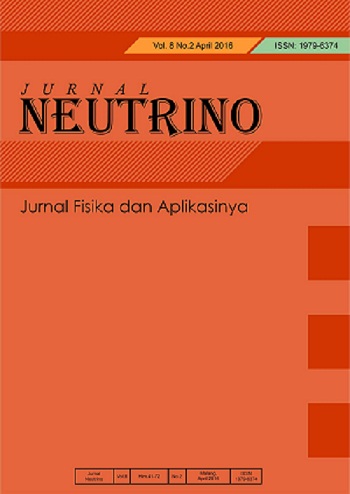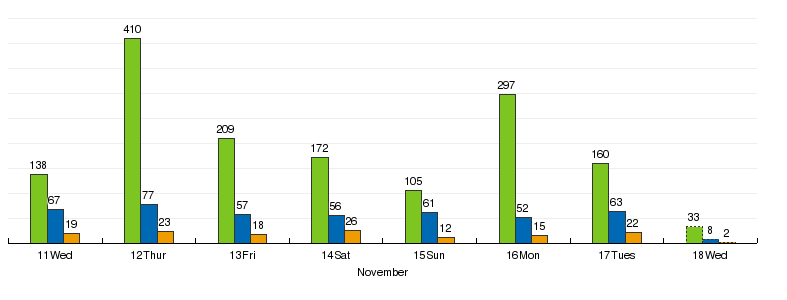INVESTIGATION ON PHYSICAL AND ELECTRICAL PROPERTIES OF THE SiO2-ZnO NANOCOMPOSITE AT DIFFERENT COMPOSITION MIXINGS
Abstract
Physical and electrical properties of The SiO2-ZnO mixing at different compositions were investigated. The experiment used simple mixing method at the sintering temperature 600oC. It was used the composition mixing ratio of SiO2:ZnO ie. 0:10; 7:3; 5:5; 3:7; and 10:0 (%Wt). Based on X-Ray Diffraction (XRD) results, it obtained that a new phase in each sample was not formed even though having different diffraction peak. The mixing ratio of SiO2: ZnO nanocomposite (7:3 %wt) had the biggest grain size (77,92 nm), the highest dielectric constant (3.00E+05) and the smallest conductivity (0,726549 (Ωm)-1). On the other side, the mixing ratio of SiO2: ZnO nanocomposite (5:5 %wt) had the smallest grain size (35.42nm), dielectric constant (3.00E+2) and the highest conductivity (25.36729 (Ωm)-1). It can be concluded that the difference of composition ratio offered the change on both physical and electrical properties of SiO2-ZnO nanocomposite.
Keywords
Full Text:
PDFReferences
Z. L. Wang. Zinc oxide nanostructures: growth, properties, and applications. J. Phys. Condens. Matter. Jun. 2004;16(25) :R829–R858,.
A. M. Ali, F. A. Harraz, A. A. Ismail, S. A. AlSayari, H. Algarni, and A. G. Al-Sehemi. Synthesis of amorphous ZnO–SiO2 nanocomposite with enhanced chemical sensing properties. Thin Solid Films. Apr. 2016; 605:277–282.
F. A. Harraz, A. A. Ismail, A. A. Ibrahim, S. A. Al-Sayari, and M. S. Al-Assiri, Highly sensitive ethanol chemical sensor based on nanostructured SnO2 doped ZnO modified glassy carbon electrode. Chem. Phys. Lett., Oct. 2015;6399Supplement C):238–242.
J. Huang, Z. Yin, and Q. Zheng. Applications of ZnO in organic and hybrid solar cells. Energy Environ. Sci. Sep. 2011. 4(10):3861–3877.
K. M. Lee, C. W. Lai, K. S. Ngai, and J. C. Juan. Recent developments of zinc oxide based photocatalyst in water treatment technology: A review, Water Res. Jan. 2016; 88(Supplement C):428–448.
S. J. Pearton and F. Ren. Advances in ZnO-based materials for light emitting diodes. Curr. Opin. Chem. Eng. Feb. 2014 3(Supplement C):51–55,
Y.-Y. Peng, T.-E. Hsieh, and C.-H. Hsu, White-light emitting ZnO–SiO 2 nanocomposite thin films prepared by the target-attached sputtering method. Nanotechnology. 2006.17(1);174,
N. Hagura, T. Takeuchi, S. Takayama, F. Iskandar, and K. Okuyama. Enhanced photoluminescence of ZnO–SiO2 nanocomposite particles and the analyses of structure and composition. J. Lumin. Jan. 2011;131(1):138–146.
W. Widiyastuti, S. Machmudah, T. Nurtono, S. Winardi, and K. Okuyama. Synthesis of ZnO-SiO2 nanocomposite particles and their characterization by sonochemical method. AIP Conf. Proc., May 2017;1840(1):080008.
A. Mikrajuddin and K. Khairurrijal. Review: Nanomaterial Characterization. J. Nanosains Nanoteknologi. Jan. 2009. (In Indonesia)
DOI: https://doi.org/10.18860/neu.v10i1.4490
Refbacks
- There are currently no refbacks.
Copyright (c) 2018 Moh. Sinol, Erika Rani

This work is licensed under a Creative Commons Attribution-NonCommercial-ShareAlike 4.0 International License.
Published By:
Program Studi Fisika Fakultas Sains dan Teknologi Universitas Islam Negeri (UIN) Maulana Malik Ibrahim Malang, Indonesia
B.J. Habibie 2nd Floor
Jl. Gajayana No.50 Malang 65144
Telp./Fax.: (0341) 558933
Email: neutrino@uin-malang.ac.id
This work is licensed under a Creative Commons Attribution-NonCommercial-ShareAlike 4.0 International License
View My Stats










